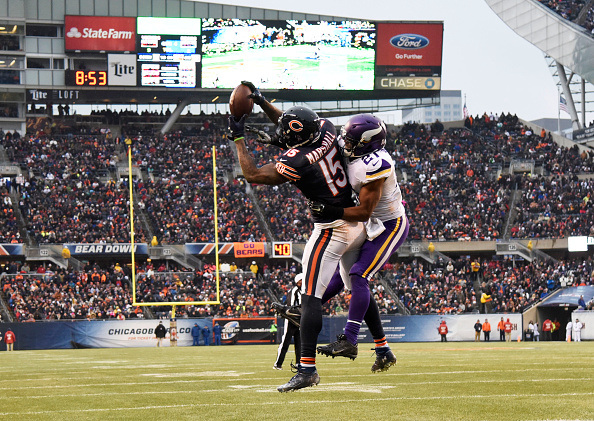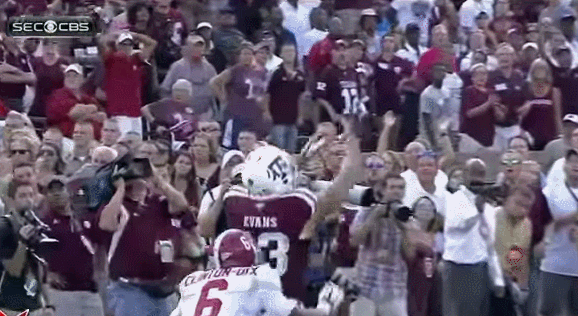
In the realm of football discussion, certain mantra is thrown around mindlessly without true understanding of what the term (or terms) mean. Similar to my recent exposure of the “game manager” quarterback label, there is a misconception about what “catch point ability” is for wide receivers.
More times than not, saying a player has great catch point ability is a catch-all term that groups the ability to catch in traffic with the ability to find the ball at its peak and pluck it out of the air. The two abilities are separate entities, yet, as I said, the phrase “catch point ability” is almost always meaning that a player can do both.
What has become maddening is that a player may only possess one of the two traits, yet they are dubbed as great “catch point” players. To get a clearer picture of prospects (and NFL players alike), there must be a differentiation of the two traits as separate terms.
As I hinted at, there are wide receivers who posses one trait, but not the other. Two glaring examples are DeVante Parker of Louisville University and Kelvin Benjamin of the Carolina Panthers. Both have absurd leaping ability and can find the ball at a point higher than anyone else, but they so often fall short when they are forced to assert themselves physically, even despite both of them being 6’3″-plus and solid frames (Benjamin more so than Parker, but still).
Both Benjamin and Parker have unbelievable hops that make themselves bigger targets for their quarterback. Below,each receiver gets sky-high and picks a pass out of the air effortlessly. For most receivers, these are incomplete.
Whew.
As impressive as those plays were, it is wrong to say Parker and Benjamin are great “catch point” players because of how poorly they position their bodies when having to deal with other bodies in traffic.
You’d think that a 6’3″, 200 pound-plus receiver could assert himself in front of defenders and consistently get inside position on the ball, but in the case of Parker and Benjamin, that is false.
Parker gets separation here, so part of the overall failure of the play is on Teddy Bridgewater, but Parker has a shot to make this play. Instead of moving under the ball and getting inside positioning to win with his body, Parker waits for the pass to come to him, resulting in the defensive back being able to make a clean play on the catch point.
Benjamin is 6’5″, 240-plus pounds. Desmond Trufant is 6’0″, 185 pounds. Physics tells me that Benjamin should have won this battle for position with ease, but Benjamin is defiant. Benjamin needs to assert himself, hop in front of Trufant and box him out, but instead, he takes the passive approach and allows Trufant to jump out in front for the interception.
For a contrast to the “high point, but not catch point” types, I turn to a former Carolina Panther and current Baltimore Raven, Steve Smith Sr.
Smith does not win with leaping ability or being able to snatch balls out of the air at their peak, but where he does win is being able to get inside positioning and hold onto tough catches. This route is no different than Benjamin’s, but Smith is able to drive inside of the cornerback and win the position battle, as well as hold onto the ball while being hit and dragged to the ground. To compare to Benjamin, Smith is 5’9″, 195 pounds.
Of course, perfect catch point ability means that one can both high-point and earn inside position to win catches in traffic. Rookie Mike Evans of the Tampa Bay Buccaneers is a blend of both traits, and it is quite a joy to watch.
 Among multiple defenders, one of which being fellow first round pick Ha Ha Clinton-Dix, Evans goes up and snags the ball before anyone else has a shot at it.
Among multiple defenders, one of which being fellow first round pick Ha Ha Clinton-Dix, Evans goes up and snags the ball before anyone else has a shot at it.
 This ball is underthrown, but unlike Parker, Evans works back inside to get behind the cornerback who has his back turned. Evans even holds onto the ball with the defender having his hand in between his arms trying to rip the ball out. Evans displayed ability to use his size and strength to his advantage, which is key for someone who doesn’t work that well laterally.
This ball is underthrown, but unlike Parker, Evans works back inside to get behind the cornerback who has his back turned. Evans even holds onto the ball with the defender having his hand in between his arms trying to rip the ball out. Evans displayed ability to use his size and strength to his advantage, which is key for someone who doesn’t work that well laterally.
Evans is quite the specimen. While there are certainly others in the league much like him, Evans is the newest of the bunch, making his transition to the NFL the clearest in the mind of football watchers everywhere.
Mike Evans is the definition of a true “catch point” receiver. He can both high-point and dominate in traffic with ease. I did not even highlight this ability, but Evans has also shown that he can use his physicality to separate in small spaces, which lowers the amount of contested catch points he has to deal with. Everything Evans does with his body to get to the body is textbook and his play should be seen as a model for young receivers built like him.
Players like Parker, Benjamin and Smith (the younger two have time to develop, to be fair) are not complete “catch point” players because they all only have one of the two implied traits. That does not necessarily make them bad players, but it does mean that they are being advertised as something that they aren’t.
Of course, I am not alone in my thinking. Mike O’Connor of TurnOnTheJets, who is one of the smartest wide receiver minds that I know, joins me in sharing his very similar opinion.
“A receiver can really mislead people to think he’s dominant at winning contested catches with athleticism and the ability to highpoint the football that typically comes with it. Just because a receiver has the leaping ability to elevate over defenders, doesn’t mean he will generate consistency at the catch point. In fact, the two facets are entirely different. Highpointing really isn’t a key skill, it’s just one of the many factors that can make a receiver dominant in winning at the catch point.
It should be obvious that there’s no direct correlation between the two often linked skills. For one, highpointing is typically how a receiver will capitalize on a play. However, they’re so many skills to consider before the receiver can get a result. Without maintaining proper leverage through physicality and having adept body control, the receiver won’t even get the chance to win the ball over the defender.
Even then, highpointing is just half the battle in winning the catch. If a receiver isn’t synched to deal with last second adjustments by the defensive back, he’s going to be thrown off when his synchronization for his catch attempt matters most. Thus, timing essentially holds equal value as winning athletically. Proper timing is also tied into how the receiver tracks the football. For instance, a receiver who flows with the defender through the entire play but times the arrival of the football with an undercut of the man in coverage might not even have to highpoint the football. No matter how the receiver chooses to win the ball, relying on just finding the ball and jumping higher than the defender will never yield respectable consistency in catch point success.“
Mike’s talk of synchronization of movements and positioning is just another way of saying what I did about Benjamin/Parker in their failed “catch in traffic” examples.
The common definition of a “catch point” receiver isn’t wrong, it is just too often thrown around for incomplete players who do not truly fit the description. People do not need to stop using the term, that is not what I am saying. Rather, there ought to be a more clear understanding of what the term means and how many receivers/tight ends truly match the profile.


